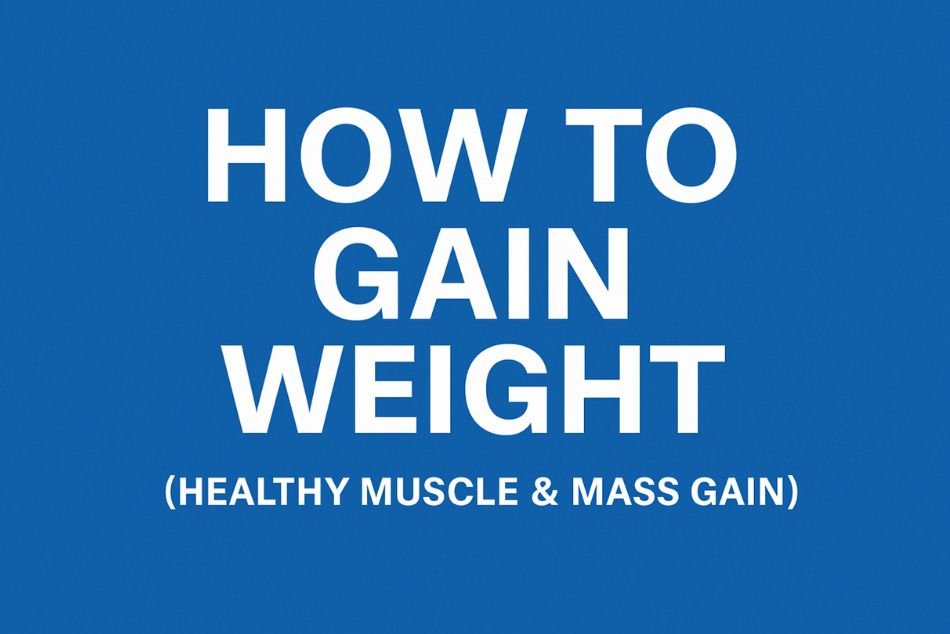How to Gain Weight the Right Way
If you want to know how to gain weight without just adding fat, you’re in the right place. Gaining weight the healthy way means building muscle, improving strength, and increasing your energy reserves while maintaining a healthy body fat level.
This guide is a complete, practical roadmap — from the science behind gains to exact meal examples, a 12-week training plan, troubleshooting, and tracking. Read it straight through or skip to the sections you need.
Understanding the Basics: What Actually Causes Weight Gain
At its core, weight change is about maintaining energy balance: balancing the calories you consume with the calories you expend. If you consistently consume more calories than your body burns, you will gain weight. But the composition of that weight — muscle versus fat — depends on what you eat, how you train, how you recover, and individual factors like genetics and hormones.

Key Principles
- Caloric Surplus: A modest, consistent surplus drives muscle growth when paired with resistance training.
- Protein and Resistance Training: Protein supplies the building blocks for muscle, and training provides the stimulus.
- Progressive Overload: Continually increasing load or volume ensures muscle adaptation.
- Recovery and Sleep: Muscle tissue repairs and grows between workouts.
- Patience: Realistic progress over months is better than rapid, unsustainable weight gain.
The Science in Detail
Energy Balance and the Size of Your Surplus
A surplus of approximately 250 to 500 calories per day is a sensible starting point for most individuals seeking to build lean mass. Too small a surplus yields slow progress. Too large a surplus mostly adds fat.
Macronutrients: What to Eat and Why
- Protein: Aim for about 1.6 to 2.2 grams per kilogram of bodyweight. Protein supports muscle protein synthesis and helps preserve lean mass during any small fat gain.
- Carbohydrates: The main fuel for hard workouts. Higher carbohydrate intake supports performance and recovery.
- Fat: Needed for hormone production and calorie density. Don’t cut fat too low.
Training Stimulus Matters
Without resistance training, extra calories become fat more often than muscle. Focus on multi-joint compound lifts — squats, deadlifts, bench press, rows, and overhead presses — and add accessory lifts where needed.
Hormones, Sleep, and Activity
Testosterone, insulin, and growth hormone influence how you gain. Sleep quality and quantity (7 to 9 hours for most adults) strongly affect recovery and hormone regulation. Also watch non-exercise activity (NEAT); if you fidget and move a lot, your calorie needs will be higher.
Step-by-Step Plan: Exactly What to Do
Below is a practical plan you can start this week. It covers calculations, macros, food choices, training, and recovery.
Step 1 — Calculate Your Calorie Target (Example Included)
Estimate your Basal Metabolic Rate (BMR) with the Mifflin-St Jeor formula, then multiply by activity to get Total Daily Energy Expenditure (TDEE). Then add a surplus.
Let’s walk through one clear example so you can replicate it.
Example person: male, 25 years old, weighing 60 kg, and 175 cm in height.
Mifflin-St Jeor for men: BMR = (10 × weight in kg) + (6.25 × height in cm) − (5 × age in years) + 5.
Calculate Step by Step:
- 10 × 60 = 600.
- 6.25 × 175 = 1,093.75.
- 5 × 25 = 125.
- Sum the components: 600 + 1,093.75 − 125 + 5.
- 600 + 1,093.75 = 1,693.75.
- 1,693.75 − 125 = 1,568.75.
- 1,568.75 + 5 = 1,573.75.
So BMR = 1,573.75 kcal, round to 1,574 kcal.
Next, pick an activity factor. For moderate activity, 1.55 is common:
TDEE = 1,573.75 × 1.55.
Compute:
1,573.75 × 1.55 = 1,573.75 × (1 + 0.55) = 1,573.75 + (1,573.75 × 0.55).
1,573.75 × 0.55 = 865.5625.
Add: 1,573.75 + 865.5625 = 2,439.3125.
Round to 2,440 kcal for TDEE.
Add a 300 kcal surplus: 2,440 + 300 = 2,740 kcal per day target.
If you want a slightly faster gain, add 400 to 500 kcal instead, but expect more fat. If you’re not gaining after two weeks, increase by 100 to 200 kcal and re-test.
Step 2 — Set Macronutrients
Using the 2,740 kcal target:
- Protein: pick 2 g/kg × 60 kg = 120 g protein. Each gram of protein = 4 kcal. So protein calories = 120 × 4 = 480 kcal.
- Carbohydrates: aim for roughly 45–55% of your daily calories for optimal performance. If we use 50%, the carb calories are 2,740 × 0.50 = 1,370 kcal. Each gram carb = 4 kcal, so carb grams = 1,370 ÷ 4 = 342.5 g. Round to 343 g.
- Fats: remaining calories = 2,740 − (480 + 1,370) = 2,740 − 1,850 = 890 kcal. Each gram of fat = 9 kcal, so fat grams = 890 ÷ 9 = 98.9 g, round to 99 g.
So macros approximate: 120 g protein, 343 g carbs, 99 g fat.
If you prefer fewer carbs, increase fat slightly and adjust accordingly.
Step 3 — Choose Calorie-Dense, Nutrient-Dense Foods
If you feel full fast, favor calorie-dense but wholesome foods:
- Nuts, nut butters, seeds.
- Full-fat dairy, like Greek yogurt, cheese, and whole milk.
- Healthy oils added to meals (olive, avocado).
- Dried fruit and granola.
- Rice, oats, starchy tubers.
- Smoothies or shakes to add calories without large volumes.
Sample high-calorie shake: whole milk 400 ml (about 240 kcal), 1 scoop whey (120 kcal), 2 tablespoons peanut butter (190 kcal), 1 banana (100 kcal), 1/2 cup oats (150 kcal). Total roughly 800 kcal and plenty of protein and carbs.
Step 4 — Train for Muscle Growth
Training Priorities:
- Focus on compound lifts, including the squat, deadlift, bench press, row, and overhead press.
- Rep ranges of 6–12 reps for hypertrophy are effective, with some lower-rep strength work (3–6 reps) mixed in to move heavier loads.
- Volume: 10–20 sets per major muscle group per week is a typical target, distributed across workouts. Beginners need less; intermediates need more.
- Progressive overload: add weight, reps, sets, or improve technique on a weekly basis.
- Frequency: train each muscle 2–3 times per week when possible.
Sample Week (Intermediate, 4 Sessions):
- Day 1: Lower body heavy — Back squat 5×5, Romanian deadlift 3×8, leg press 3×12, calf raises 4×12.
- Day 2: Upper body push — Bench press 5×5, overhead press 3×8, incline dumbbell press 3×10, triceps 3×12.
- Day 3: Rest or engage in light mobility and take a walk.
- Day 4: Lower body volume — Deadlift 4×6, lunges 3×10, hamstring curls 3×12, core work.
- Day 5: Upper body pull — Rows 4×8, pull-ups 4×6, face pulls 3×15, biceps 3×10.
- Day 6: Optional accessory or full-body circuit focusing on lagging parts.
- Day 7: Rest.
Adjust reps and sets by experience. Beginners often respond well to full-body training 3×/week with compound lifts.
Step 5 — Recover Effectively
- Sleep 7–9 hours per night.
- Plan rest days and deload weeks. After 4–8 weeks of progressive load, reduce volume for one week.
- Manage stress. High stress increases cortisol and can impact recovery.
- Keep alcohol moderate; it impacts recovery and appetite regulation.
Practical Weekly Meal Plan Examples
Below are two full-day examples: one for omnivores and one for vegetarians. Both target similar calories.
Omnivore – Approximately 2,700–2,900 Kcal
- Breakfast: 80 g Oats cooked in 350 ml whole milk, 1 banana, 2 tbsp peanut butter, 1 scoop whey.
- Mid-Morning Snack: 200 g Greek yogurt with honey and a handful of almonds.
- Lunch: 150g Chicken breast, 200g cooked rice, 1 avocado, mixed salad with olive oil.
- Afternoon Shake: 400ml whole milk, 1 scoop whey protein, 50g oats, 1 tbsp honey.
- Dinner: 180 g salmon, 200 g sweet potato, mixed vegetables with olive oil.
- Evening Snack: 200 g cottage cheese with berries and walnuts.
Vegetarian – Approximately 2,600–2,800 Kcal
- Breakfast: 100 g oats with 350 ml whole milk, 2 tbsp almond butter, a banana, and 1 scoop plant protein.
- Snack: Peanut butter sandwich on whole wheat bread and a glass of milk.
- Lunch: Paneer curry, 200g paneer, 200g rice, side salad with a drizzle of oil.
- Afternoon Shake: Whole milk, dates, oats, protein powder.
- Dinner: Lentil curry (dal), quinoa, roasted vegetables with olive oil.
- Evening Snack: Greek yogurt or cottage cheese with nuts.
Supplements: Useful, Not Magical
- Creatine Monohydrate: 3 to 5 g daily is supported by strong evidence for strength and lean mass gains.
- Whey or Plant Protein: Helps meet protein targets, especially post-workout or in shakes. Typical serving = 20–30 g protein.
- Mass Gainers: High-calorie powders can help reach high-calorie targets, but check the sugar and ingredient lists.
- Omega-3, vitamin D, and multivitamins: sensible for general health if your diet lacks variety.
Supplements help but don’t replace training, calories, or sleep.
A 12-Week Sample Progression Plan
Weeks 1–4: Build a foundation. Use moderate volume and focus on technique. Aim to increase weight in a linear fashion, for example, by adding 2.5–5 kg to compound lifts when you can.
Weeks 5–8: Increase intensity and volume slightly. Add 1–2 accessory exercises per session to target weak points.
Weeks 9–12: Push for higher loads and aim for improved performance metrics (e.g., more reps at existing weights, better bar speed). Include a planned deload week after week 12.
Track Performance: Log weight, reps, and sets for every session. If you stall, look at diet, sleep, stress, and the possible need for a programmed deload.
Tracking Progress and Adjustments
- Weigh once per week under similar conditions, e.g., first thing in the morning after using the bathroom and before breakfast.
- Track circumference measures: chest, waist, hips, arms, thighs. These show composition changes better than weight alone.
- Keep a training log and a rough food log for at least one week when you start, so you know what you’re actually eating.
- If weight gain is less than 0.25 kg per week over two to three weeks, increase calories by 100–200 kcal. If you’re gaining more than 0.7–1.0 kg per week, reduce the surplus slightly to limit fat.
Common Mistakes and How to Avoid Them
- Eating large amounts of low-quality junk food. You can gain weight on junk food, but performance, recovery, and health suffer.
- Expecting instant results. Real muscle growth is slow. Focus on consistent habits for months.
- Training like a bodybuilder without progressive overload. Volume matters, but so does adding weight or reps over time.
- Overdoing cardio. You can include cardio, but too much can counteract your surplus and slow your gains. Two short sessions per week are a good baseline for cardiovascular health.
- Not tracking food accurately. Many people underestimate calories. Use a food scale and logging app for the first few weeks.
Here’s What You Should Do You’re Your Progress Stalls
If you’re not gaining weight after 4 weeks despite following the plan:
- Re-check calories. Weigh food and log intake for 7 days.
- Add one extra snack or a calorie-dense shake per day.
- Reduce excessive NEAT if possible, such as taking long daily walks that burn a large number of calories. You don’t need to eliminate movement, but be aware of its effect.
- Rule out medical causes with a doctor if nothing changes; conditions such as hyperthyroidism, chronic infections, or malabsorption can affect weight.
Wrapping Up
Learning how to gain weight in a healthy, sustainable way is a process of small, consistent improvements. Set a realistic calorie target, prioritize protein and compound exercises, track your progress, and adjust your approach as needed. Lastly, be patient — build habits that you can maintain for months to come.
Frequently Asked Questions
How Quickly Can I Gain Muscle?
Beginners can expect faster initial gains, sometimes gaining 1–2 kg of lean mass per month, while experienced lifters progress more slowly.
Will I Get Fat While Gaining?
Some fat gain is common—a moderate surplus and steady progress limit fat gain while encouraging muscle growth.
Do I Need Supplements?
No. Supplements are convenient but optional. Whole foods and consistent training are the foundation.
Is Meal Timing Important?
Total daily calories and protein are the most important factors. Spread protein across meals if possible to optimize muscle protein synthesis.







